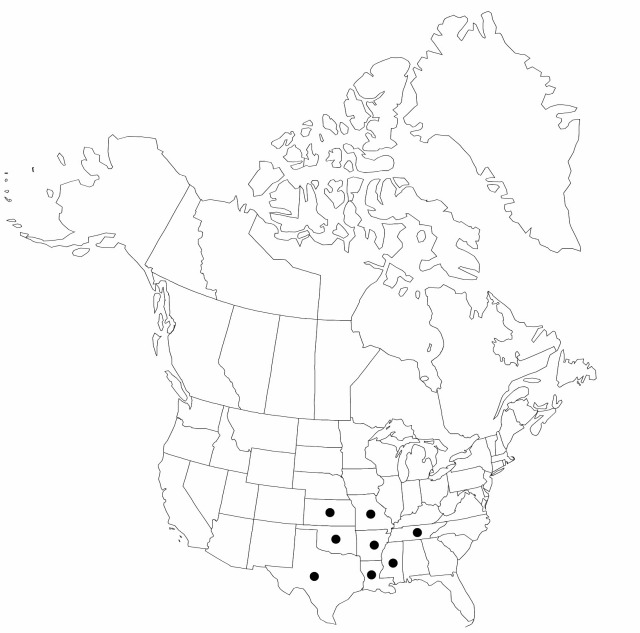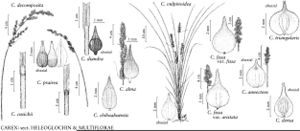Difference between revisions of "Carex triangularis"
Flora 39: 226. 1856.
FNA>Volume Importer |
FNA>Volume Importer |
||
| Line 11: | Line 11: | ||
|name=Carex vulpinoidea var. drummondiana | |name=Carex vulpinoidea var. drummondiana | ||
|authority=Boeckeler | |authority=Boeckeler | ||
| − | }}{{Treatment/ID/Synonym | + | }} {{Treatment/ID/Synonym |
|name=Carex vulpinoidea var. triangularis | |name=Carex vulpinoidea var. triangularis | ||
|authority=(Boeckeler) Kükenthal | |authority=(Boeckeler) Kükenthal | ||
| Line 29: | Line 29: | ||
|elevation=0–600 m | |elevation=0–600 m | ||
|distribution=Ark.;Kans.;La.;Miss.;Mo.;Okla.;Tenn.;Tex. | |distribution=Ark.;Kans.;La.;Miss.;Mo.;Okla.;Tenn.;Tex. | ||
| − | |discussion=<p>The red-dotted perigynia of Carex triangularis separates the species from all other taxa in the section; however, it is similar to C. annectens in the relative lengths of leaves and flowering stems, and in the yellow-brown, ovate perigynia that are larger and broader than in C. annectens.</p> | + | |discussion=<p>The red-dotted perigynia of <i>Carex triangularis</i> separates the species from all other taxa in the section; however, it is similar to <i>C. annectens</i> in the relative lengths of leaves and flowering stems, and in the yellow-brown, ovate perigynia that are larger and broader than in <i>C. annectens</i>.</p> |
|tables= | |tables= | ||
|references= | |references= | ||
| Line 53: | Line 53: | ||
|publication year=1856 | |publication year=1856 | ||
|special status= | |special status= | ||
| − | |source xml=https://jpend@bitbucket.org/aafc-mbb/fna-data-curation.git/src/ | + | |source xml=https://jpend@bitbucket.org/aafc-mbb/fna-data-curation.git/src/8f726806613d60c220dc4493de13607dd3150896/coarse_grained_fna_xml/V23/V23_483.xml |
|genus=Carex | |genus=Carex | ||
|section=Carex sect. Multiflorae | |section=Carex sect. Multiflorae | ||
Revision as of 16:08, 18 September 2019
Culms to 100 cm × 2 mm, scabrous. Leaves: sheath fronts spotted red-brown or pale brown, apex short-convex, membranous or slightly thickened, rugose; ligule retuse, to 0.5 mm, free limb to 0.1 mm; blades 70 cm × 5 mm, tip not reaching inflorescence. Inflorescences spicate, 2.5–6 × 1.5 cm, with 10–15 branches, proximal scarcely separate; the proximal internode to 10 mm; proximal bracts setaceous, not conspicuous, distal bracts scalelike. Scales hyaline, brown, awn to 2 mm, usually shorter than scale body. Perigynia yellow-brown, red dotted, 3–5-veined abaxially, body broadly ovate, 2.5–5 × 2.5–3 mm, base rounded; beak 0.8–1.2 mm. Achenes red-brown, elliptic, 1.4–1.6 × 1.2 mm, dull.
Phenology: Fruiting Jun.
Habitat: Open habitats, wet meadows, wet prairies, roadside ditches in seasonally saturated or inundated soils
Elevation: 0–600 m
Distribution

Ark., Kans., La., Miss., Mo., Okla., Tenn., Tex.
Discussion
The red-dotted perigynia of Carex triangularis separates the species from all other taxa in the section; however, it is similar to C. annectens in the relative lengths of leaves and flowering stems, and in the yellow-brown, ovate perigynia that are larger and broader than in C. annectens.
Selected References
None.
